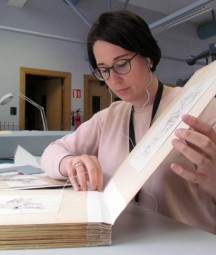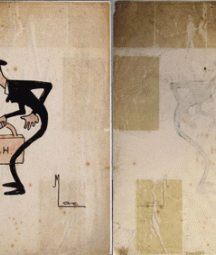by Felix M. Larkin, vice-chair of the NLI Society and member of the NLI’s statutory Readers Advisory Committee. His book Terror and Discord: The Shemus Cartoons in the Freeman’s Journal, 1920–1924 was published by A&A Farmar in 2009
In December 2006 the National Library of Ireland acquired some 250 original drawings of the Shemus cartoons that appeared in the Freeman’s Journal between 1920 and 1924, the final years of that old and distinguished Irish newspaper. They have now been digitised and are available to view on the NLI’s online catalogue.
These cartoons are remarkably hard-hitting comments on the events of this bitterly contested period in Irish history. Up to the truce of July 1921, which led on to the Anglo-Irish Treaty in the following December, the main thrust of the cartoons was to react to the increasingly brutal nature of British rule in Ireland. Thereafter, they targeted principally the new government of Northern Ireland and the anti-Treaty elements in the new Irish Free State.
The cartoons complemented the Freeman’s editorial policy at that time, and the fact that the newspaper saw itself as an important player in the unfolding events is evident in the cartoons. For instance, the cartoon entitled ‘Under the Greenwood Tree’ (published 3 April 1921) reflects the Freeman’s self-image as a bulwark against the British government and the excesses of the British military forces in Ireland during the War of Independence.
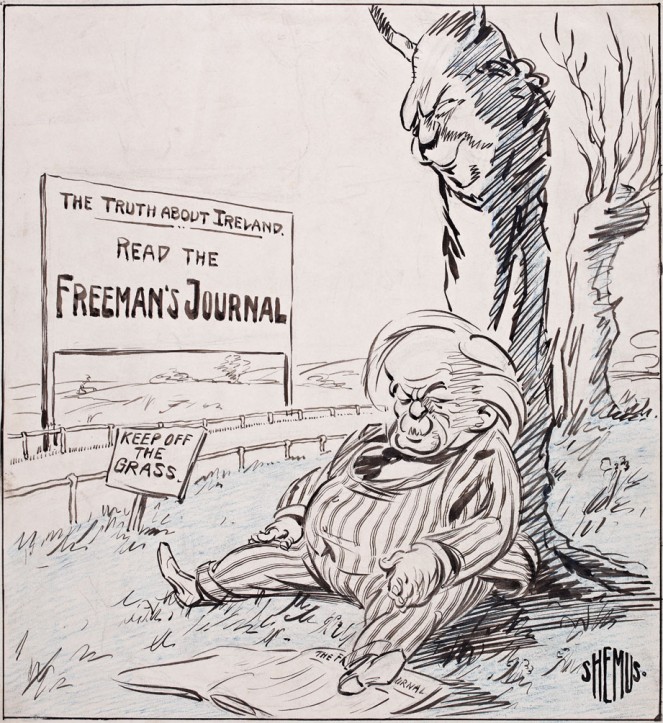
Under the Greenwood Tree by Shemus. NLI ref. PD 4309 TX 76
This cartoon depicts Lloyd George and Sir Hamar Greenwood, respectively the British prime minister and the chief secretary for Ireland. The title of the cartoon links Greenwood’s surname with a readily recognisable passage from Shakespeare’s As You Like It – ‘Under the greenwood tree, / Who loves to lie with me’. Greenwood is thus the tree against which Lloyd George lies, his left foot holding down a copy of the Freeman – and the message is that the Freeman’s fearless reporting is frustrating the efforts of both Lloyd George and Greenwood to cover up the truth about British policy in Ireland.
Shemus the cartoonist was Ernest Forbes (1879–1962), an Englishman who had come to Ireland to join the Freeman’s staff in 1920. He was later a noteworthy landscape artist and portrait painter in London and in his native Yorkshire. He used a number of pseudonyms in his long career, and even ‘Ernest Forbes’ was a contrivance: his full name was Ernest Forbes Holgate and he dropped the surname when signing his work. In 1927 he changed his name by deed poll to Ernest Forbes. The pseudonym ‘Shemus’ was exclusive to the Freeman’s Journal.
When Forbes joined the Freeman’s Journal in 1920, the paper’s principal proprietor was Martin Fitzgerald – a rambunctious figure, who had founded a firm of wine merchants in Dublin and was prominent in the commercial and sporting life of the city in the early years of the last century. His main sporting interest was horse-racing. An associate of his in horse-racing circles was R. Hamilton Edwards, a retired British journalist who had once worked with Lord Northcliffe in London but was now living in Ireland. Fitzgerald and Edwards jointly purchased the Freeman’s Journal in October 1919. It had been the semi-official organ of the Irish Party at Westminster since Parnell’s time. Accordingly, after the 1918 General Election and Sinn Fein’s triumph over that earlier nationalist tradition, it lost its raison d’être and was forced into liquidation some weeks before its purchase by Fitzgerald and Edwards.
It is likely that Hamilton Edwards, with his experience and connections in London, recruited Forbes to the Freeman – and the Shemus cartoons are broadly similar in style to cartoons that had been appearing in London newspapers such as the Daily Mirror and the Daily Mail, both Northcliffe publications. Forbes retained an essentially British mindset throughout his sojourn in Ireland. His work for the Freeman during the War of Independence mirrored the British liberal critique of British policy in Ireland, a critique based principally on what British journalists were reporting from Ireland. He was at his best when treating of his Irish subject matter from the perspective of British politics and focusing on British politicians. A good example is the cartoon entitled ‘The Carson Kids’ (published 19 November 1920).
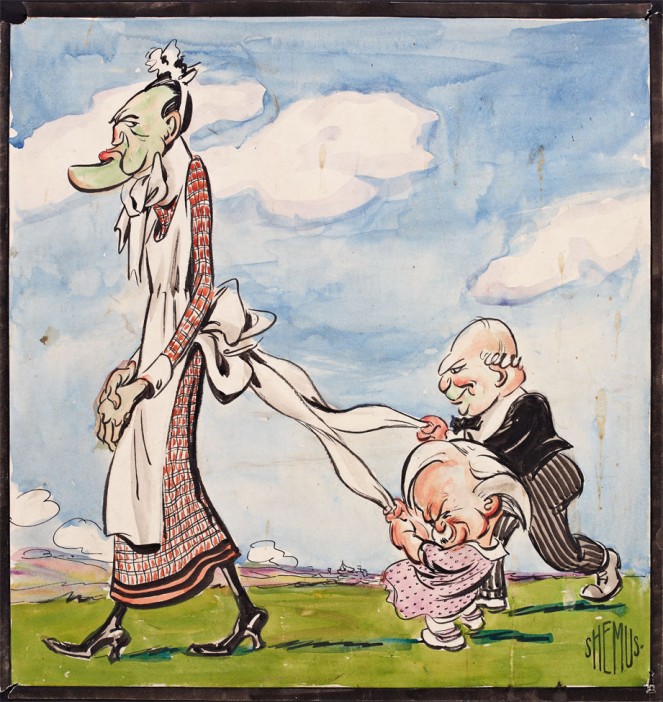
The Carson Kids by Shemus. NLI ref. PD 4309 TX 52
This is one of only three Shemus cartoons in the National Library’s collection to have been finished in watercolour. Lloyd George and Greenwood are portrayed as children clutching Sir Edward Carson’s apron strings. The implication is that, with Lloyd George dependent on the support of the Conservative Party to continue in office, Carson can dictate British policy in Ireland.
Lloyd George, Greenwood and Carson also feature in the next cartoon reproduced here. It marks the introduction of partition under the Government of Ireland Act 1920, and is entitled ‘The Six Counties’ (published 28 May 1921). The first elections to the new parliament of Northern Ireland had just taken place. In the cartoon, the six counties of Northern Ireland are denoted by bubbles blown from Sir Edward Carson’s toy pipe. Sir James Craig, the first Prime Minister of Northern Ireland, is borne aloft on top of the bubbles, while Lloyd George and Greenwood look on from a distance.
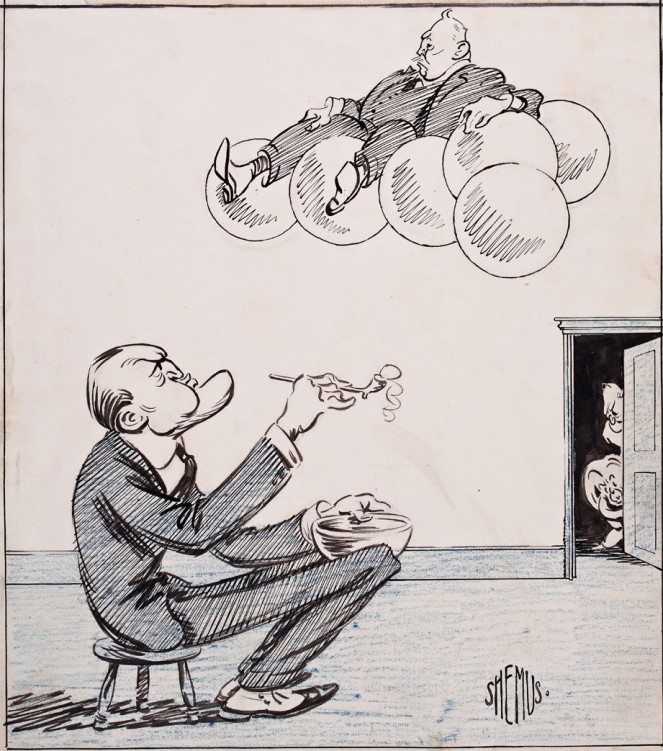
The Six Counties by Shemus. NLI ref. PD 4309 TX 80
The Freeman’s support for the Anglo-Irish Treaty of 1921 was generally regarded, even on the pro-Treaty side, as unduly partisan. It was marked by intemperate editorials, the suppression of anti-Treaty manifestos and speeches, and a series of notably malevolent cartoons attacking the anti-Treatyites with all the venom previously directed against the British authorities. The most notorious of these cartoons ‘Giving him his lines’ (published 10 February 1922) caricatures Éamon de Valera as the somewhat demented mouthpiece of his close associate, Erskine Childers.
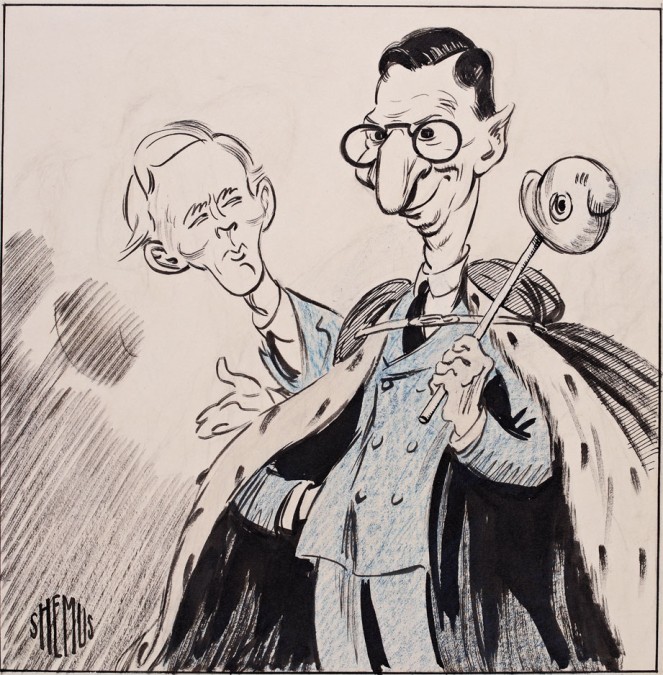
Giving him his lines by Shemus. NLI ref. PD 4309 TX 104
This cartoon appeared shortly after the Treaty had been ratified and de Valera had resigned as President of the Dáil Éireann executive. In the cartoon, Dev is arrayed in the ermine-edged robe of a peer – implying a disdain for democracy. He also holds the French revolutionary ‘Liberty Cap’, the bonnet rouge. In the caption to the cartoon, Childers says to Dev: ‘That’s fine. They fit you as well as ever – all except the cap. Now, don’t forget to say it exactly as I told you’.
Ireland’s gradual descent into civil war later in 1922 occasioned what is probably the best of all the Shemus cartoons – for, in addition to the punch that it packs, it is a most accomplished and skilful piece of drawing. It was published on 26 April 1922, shortly after the occupation of the Four Courts in Dublin by armed anti-Treatyites – the prelude to the outbreak of the civil war. Entitled ‘It Means Nothing to Them’, the caption has one of the gunmen in the foreground asking ‘What’s all the noise?’ to which the second replies ‘Don’t worry. It’s only the voice of the unarmed people’. The ‘unarmed people’ can be seen in the bottom left-hand corner of the cartoon.
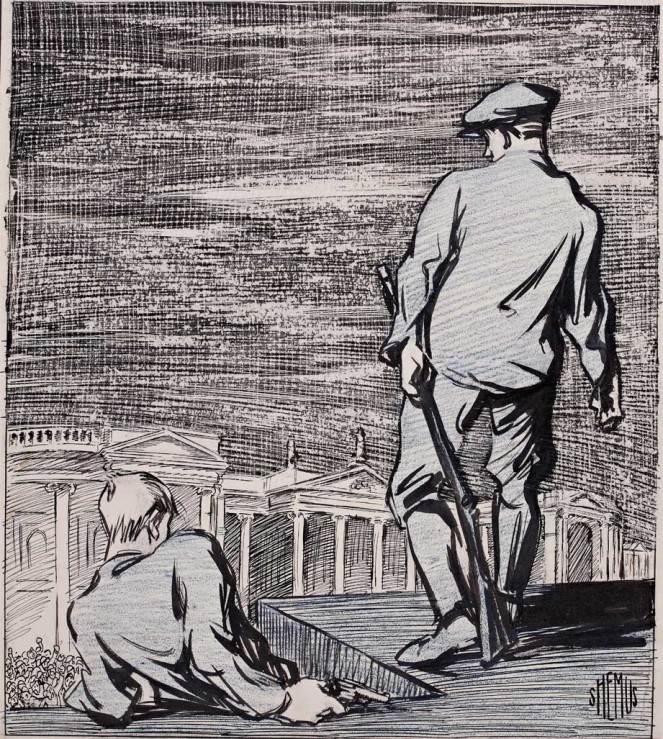
It Means Nothing to Them by Shemus. NLI ref. PD 4309 TX 118
The unambiguous message of this cartoon is that armed resistance to the Treaty, represented by the skilfully drawn gunmen, flouts majority opinion in Ireland. The building in the background is the Bank of Ireland in College Green, Dublin, the seat of the last Irish parliament before the Act of Union of 1800.
The Shemus cartoon that resonates most with us today is the one that appeared in the Freeman after the death of Michael Collins (published 24 August 1922). It shows the female figure of Erin – and she is prostrate with grief at his death. The broken column is a traditional symbol for a life cut short, and each column in the cartoon bears the name of an Irish leader whose aims were not realised because of his untimely death. Collins is the latest in a line that includes Arthur Griffith, Charles Stewart Parnell, Daniel O’Connell and others. Their broken columns mark out ‘Ireland's Via Dolorosa’, which is the title of the cartoon.
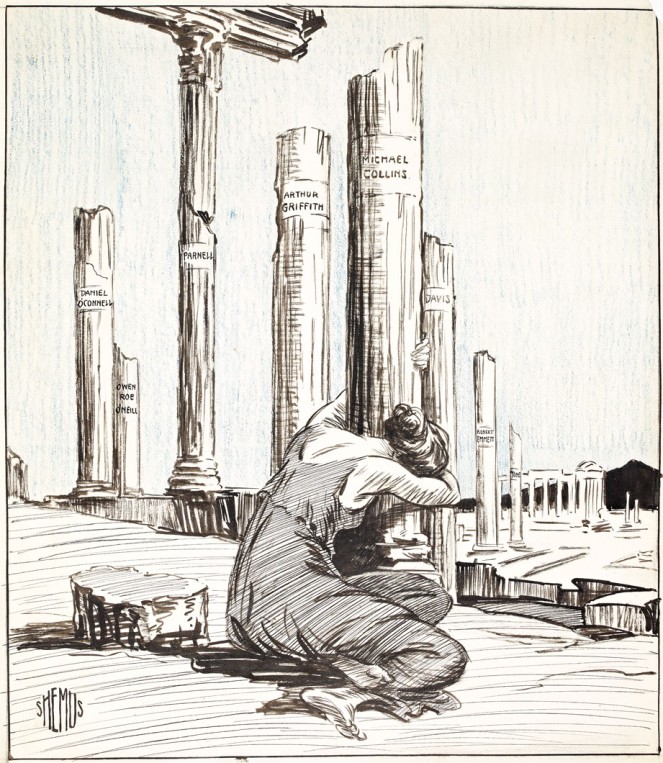
Ireland's Via Dolorosa by Shemus. NLI ref. PD 4309 TX 145
The Shemus cartoons continued to appear in the Freeman until it ceased publication in December 1924. Forbes then returned to London, where he worked on the London Evening News and also contributed caricatures to the Illustrated London News. He moved back to Yorkshire in the 1930s, and wrote a long series of pictorial articles for the Yorkshire Post on the cities, towns and villages of Yorkshire and the ordinary people of the county – using his own drawings. To quote his obituarist in the Yorkshire Post, in these articles Forbes ‘proved himself as much an artist in words as with the pencil’. With the success of this series, he was able to give up work for newspapers and concentrate on oil painting, particularly landscapes. Bizarrely, in 1946 he suffered severe head injuries and fractured ribs when attacked by a bull while painting in a field. He died in February 1962, aged 82.
In 1923 the Freeman’s Journal boasted that the Shemus cartoons ‘will not easily fade from public memory … [and] are amongst the most notable productions in the history of the cartoonist’s art’. That may be an extravagant claim, but the cartoons certainly did light up the pages of the Freeman between 1920 and 1924. With the National Library’s digitisation of the original drawings of these cartoons in its collection, it is likely that they will again become well known – deservedly so, for they are eminently suitable for use as illustrations in academic and other studies of the period. To quote Hamlet, they are ‘abstracts and brief chronicles of the time’.
